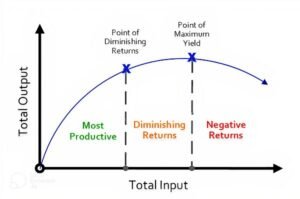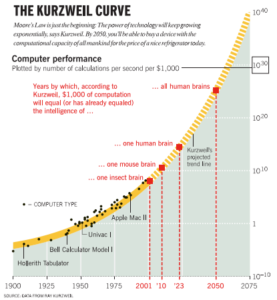Is AI Progress Slowing Down? An In-Depth Analysis
Artificial Intelligence (AI) has rapidly infiltrated various sectors, transforming everything from healthcare to finance. However, the question arises: Are we facing a slowdown in AI progress? Let’s delve into the nuances, challenges, and potential future of AI.
The Current State of AI Research
The current AI research paradigm revolves around the Transformer architecture, scalability, and multimodality. Despite significant advancements, including models with unprecedented layers and capabilities, there are indications that we might be hitting a plateau. A recent poll revealed that only 16% believe this paradigm can take us all the way to Artificial Superintelligence (ASI), while 50% think we are mostly there but need a few more breakthroughs.
Sigmoid vs. Exponential Growth
For those familiar with sigmoid and exponential curves, the early stages can look remarkably similar. The sigmoid curve, however, plateaus after a period of rapid growth. This context suggests that while AI has experienced explosive growth, there’s increasing speculation that we might be nearing a plateau.
Surveys conducted on platforms like YouTube indicate a split opinion. About 22% believe we’ve already passed the inflection point where diminishing returns set in. Another 15% think we’re at the inflection point right now, while 33% believe it’s less than two years away. This split highlights the uncertainty in predicting the future trajectory of AI.
The Exponential Technology Trends
Several technology trends have historically followed an exponential growth path, such as Moore’s Law. However, even Moore’s Law faces physical and economic limits. The same challenges apply to AI, where data proliferation and model growth are crucial yet constrained by practical limitations.
One of the significant bottlenecks is energy. Training and running large AI models require vast amounts of energy. With diminishing returns and rising costs, we might need a fundamental shift in how we approach AI development to sustain progress.
The availability and quality of data are other critical constraints. While we’ve scraped almost the entire internet for data, the focus is shifting to high-quality, curated datasets. This shift is due to findings that quality counts more than quantity, making high-quality data exponentially more expensive and harder to acquire.
Theoretical and Practical Limits
There’s often a significant gap between theoretical possibilities and practical implementations. Theoretical concepts like the Landauer limit outline the maximum compute efficiency possible. Still, practical constraints like energy, data, and material resources play a crucial role in determining what can be achieved.
The law of diminishing returns suggests that as we pump more resources into training AI models, the incremental gains get smaller. This concept is visibly impacting AI, where each leap in model size and capability requires disproportionately more input.
AI development is rife with unforeseen constraints. Whether it’s the physical limitations of hardware or the economic viability of running large models, these unanticipated challenges contribute to slowing progress.
Infrastructure and Hardware Constraints
Building infrastructure to support AI is both time-consuming and resource-intensive. Data centers require significant investments in energy, cooling, and hardware. As we scale up, these requirements become exponentially more demanding, posing a considerable challenge to sustained growth.
Training AI models is becoming increasingly expensive. For instance, training costs for models like GPT-3 were in the millions, and future models will likely cost exponentially more. This economic challenge adds another layer of complexity to sustaining AI progress.
The gap between what is theoretically possible and what is practically achievable remains wide. Whether it’s in genetic research or nuclear fusion, we’ve seen that unlocking theoretical potential often lags behind due to practical constraints.
Potential Implications for the Future
The potential slowdown in AI has both challenges and silver linings:
- A slower rate of AI advancement allows more time to adapt to safety and security concerns, an essential aspect as we integrate AI further into daily life.
- A gradual slowdown provides time for economies to adjust, potentially reducing the immediate impact on jobs and other economic factors.
Geopolitical Ramifications
The plateau in AI progression will have geopolitical implications. Nations will compete to overcome these challenges, perhaps leading to innovations in energy, data infrastructure, and other critical areas.
Future Outlook
While a full-blown AI winter seems unlikely, the pace of change might decelerate, giving us more time to adapt to the current paradigm’s benefits and challenges. This slowdown could provide a balanced approach to harnessing AI’s full potential while addressing underlying issues.
Join the Conversation
Discover more in-depth analyses and stay updated with the latest in AI. Subscribe to our newsletter and join our community here.
Conclusion
The potential slowdown in AI progress presents a double-edged sword. While there are significant challenges in data availability, energy requirements, and infrastructure, this slowdown also provides an opportunity to adapt economically and address safety concerns. The road ahead is complex but filled with both caution and promise.
Elliott’s Opinion: While the pace of AI advancements might slow down, the future holds opportunity. By addressing the challenges head-on, we can pave the way for a more secure, balanced, and innovative integration of AI into our lives.
Stay tuned for more insights as we navigate the fascinating world of AI and its implications for our future.
“`
This markdown article maintains a balance between technical depth and readability, incorporating Elliott’s unique insights and professional expertise, while encouraging user engagement through subscription hooks and blog continuity.
“`markdown
Top 5 FAQs About the Future of AI Research and Its Implications
Discover the future of AI research in this comprehensive analysis exploring whether AI progress is slowing down. Delve into current data, energy constraints, and the implications for safety, economics, and geopolitics. Uncover Elliott’s insights and predictions for the AI landscape, balancing complex challenges with promising opportunities. Subscribe for more in-depth articles and stay updated in the ever-evolving world of AI. Here are the top 5 FAQs about this intriguing topic:
1. Why is there speculation that AI progress is slowing down?
There are signs indicating that AI progress might be hitting a plateau due to several factors, including diminishing returns on resource investment, data constraints, and energy requirements. Learn more about the current state of AI research and the potential inflection points in our detailed blog post on AI progress.
2. What are the major energy constraints affecting AI development?
Training and running large AI models require vast amounts of energy. This constraint is becoming a significant bottleneck as the scaling laws suggest exponentially rising costs in both energy and resources. For an in-depth analysis, visit our section on energy constraints in AI.
3. How do data constraints impact AI research?
The availability and quality of data play a crucial role in AI development. While most available data has been exhausted, the focus is shifting toward high-quality, curated datasets that are exponentially more expensive and harder to acquire. Find out more about the implications of data constraints on AI.
4. What are the safety and security implications of a slowdown in AI progress?
A slower rate of AI advancement may provide more time to adapt to safety and security concerns, allowing for a more secure integration of AI into various sectors. For more insights on the safety ramifications, read our section on safety and security adaptations.
5. What are the potential geopolitical ramifications of an AI slowdown?
The plateau in AI progression could lead to a competitive landscape where nations strive to overcome these challenges, sparking innovations in energy, data infrastructure, and other critical areas. Uncover Elliott’s viewpoints on the geopolitical implications of AI in our comprehensive analysis.
Want to Stay Updated?
Stay informed on the latest in AI research and more by subscribing to our newsletter. Join our community and explore in-depth articles on the ever-evolving world of artificial intelligence.
Elliott’s Opinion: While the pace of AI advancements might slow down, addressing the challenges head-on will help pave the way for a more secure and balanced integration of AI into our lives. Explore the full article for deeper insights.
Stay tuned for more expert analyses as we navigate the fascinating world of AI and its future implications.
“`
This markdown output provides a structured FAQ section with relevant backlinks, encouraging in-depth exploration of the topic while keeping the readers engaged.








